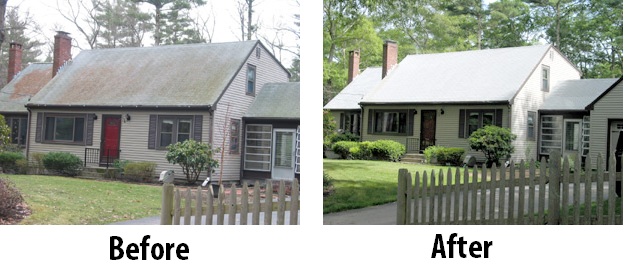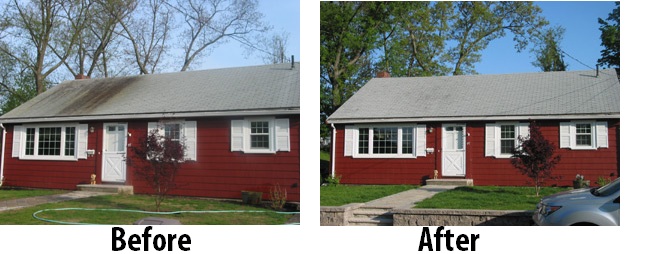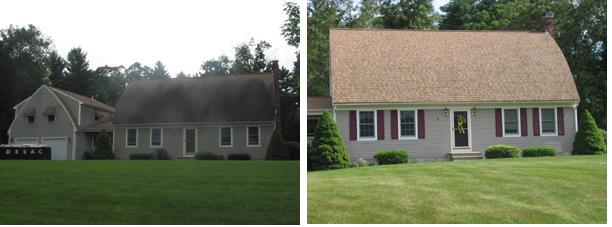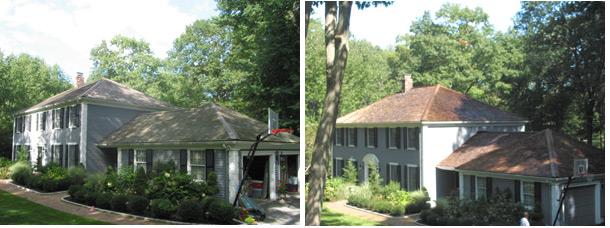Transform Your Braintree Home’s Curb Appeal with Expert Roof Washing Today!
I. Introduction
Maintaining a clean roof is often overlooked by homeowners, yet it plays a crucial role in the overall aesthetics and longevity of your property. A dirty roof can detract from your home’s curb appeal, leading to a decrease in property value and potentially costly repairs down the line. In this article, we will explore the importance of roof washing and how it can transform your home, enhancing its beauty and safeguarding your investment.
II. Understanding Roof Washing
What is Roof Washing?
Definition and Purpose
Roof washing refers to the process of cleaning the roof surface to remove unwanted substances such as dirt, algae, moss, and other debris. These contaminants not only mar the beauty of your roof but can also lead to significant structural damage over time.
The primary purposes of roof washing include:
- Aesthetic enhancement: A clean roof significantly improves the visual appeal of your home.
- Preventative maintenance: Regular washing can prevent long-term damage that may require expensive repairs.
- Increased lifespan: Removing harmful substances can extend the lifespan of your roofing materials.
Different Types of Roof Washing Techniques
There are several techniques for washing roofs, each tailored to specific types of roofing materials and the nature of the grime. The two most common methods are soft washing and pressure washing.
- Soft Washing: This method uses low-pressure water combined with specialized cleaning solutions to gently eliminate dirt and stains. It’s particularly effective for roofs susceptible to damage, such as asphalt shingles.
- Pressure Washing: Utilizing high-pressure water, this technique is ideal for removing stubborn stains but can be risky for some roof types. It’s essential to know when and how to apply pressure washing safely to avoid damaging the roofing material.
Why Roof Washing is Essential
Preventing Damage
One of the most critical reasons for regular roof washing and Braintree MA house washing is to prevent damage caused by the accumulation of harmful substances. Algae and moss can hold moisture against the roofing material, leading to rotting, decay, and even leaks. Over time, neglecting to wash your roof can result in extensive damage, requiring a full roof replacement that could have been avoided with regular maintenance.
Enhancing Aesthetic Appeal
A clean roof can dramatically enhance the overall appearance of your home. When your roof sparkles under the sunlight, it adds to the curb appeal and can even make a strong first impression on potential buyers.
Moreover, a clean roof conveys a message of care and responsibility. Homeowners who take the time to maintain their property can foster a sense of pride and neighborhood value.
In the upcoming section, we will delve deeper into the signs that your roof needs washing. Recognizing these indicators is crucial for timely maintenance and preventing further issues down the line.
Stay tuned as we explore these vital signs in our next segment!
III. Signs Your Roof Needs Washing in Braintree
Recognizing the signs that your roof requires washing is crucial for maintaining its integrity and aesthetic appeal. Many homeowners may overlook the condition of their roof until it becomes a more significant issue, leading to potential damage and increased repair costs. In this section, we will explore the key indicators that suggest it’s time to schedule a professional roof washing.
Key Indicators of a Dirty Roof
Visible Stains and Discoloration
One of the most apparent signs that your roof needs washing is the presence of visible stains or discoloration. These stains often manifest as:
- Black streaks: Usually caused by Gloeocapsa magma, a type of algae that thrives in humid environments.
- Green patches: Indicative of moss or lichen growth, which can trap moisture against the roof and lead to deterioration.
- Brown or gray areas: Often the result of accumulated dirt and debris, making your roof look worn and aged.
If you notice any of these unsightly stains, it’s a clear indication that your roof requires immediate attention.
Plant Growth on Roof
If you spot plant growth on your roof, such as moss, lichens, or even small weeds, it’s time to take action. These plants can retain moisture, leading to serious structural issues. Here’s why you should be concerned:
- Moisture retention: Plants can trap water against roofing materials, accelerating decay and rot.
- Damage to shingles: Moss can lift shingles, exposing the underlying materials to the elements and causing leaks.
- Pest attraction: The presence of plants can attract pests, further exacerbating your roof’s problems.
Increased Energy Bills
Another subtle yet telling sign of a dirty roof can be found in your energy bills. A buildup of algae, dirt, and debris can hinder your roof’s ability to reflect sunlight. This results in:
- Increased heat absorption: A dirty roof can make your home hotter in the summer months, leading to higher cooling costs.
- Decreased energy efficiency: When your roof can’t effectively insulate your home, your heating and cooling systems must work harder.
If you’ve noticed a sudden spike in your energy bills, it might be worth inspecting your roof for cleanliness.
Frequently Asked Questions
How often should I wash my roof?
The frequency of roof washing depends on several factors, including your local climate, the type of roof material, and the presence of trees nearby. As a general guideline:
- Every 1 to 3 years for asphalt shingles, especially in humid climates.
- Every 2 to 5 years for tile or metal roofs, depending on environmental conditions.
Is roof washing safe for all roof types?
Most roof types can benefit from washing, but the method must be chosen carefully.
- Asphalt shingles: Best cleaned using soft washing to avoid damage.
- Tile roofs: Can withstand pressure washing but should still be handled with care.
- Metal roofs: Generally safe with either method, but it’s crucial to avoid damaging the paint.
Can I DIY roof washing?
While DIY roof washing is possible, it is often safer and more effective to hire professionals. Here’s why:
- Safety concerns: Climbing onto a roof can be dangerous without the proper equipment and training.
- Risk of damage: Incorrect washing techniques can harm your roof, leading to costly repairs.
- Expertise: Professionals can identify problems that may go unnoticed by untrained eyes.
In our next section, we will explore the roof washing process in detail, discussing how to prepare for a washing service and what to expect during the procedure. This knowledge will empower you to make informed decisions regarding your roof’s maintenance.
Stay tuned as we dive deeper into the essential steps for ensuring your roof remains in optimal condition!
IV. The Roof Washing Process
Understanding the roof washing process is essential for homeowners seeking to maintain their property effectively. This section will provide a detailed overview of what to expect during a roof washing service, including preparation steps, the washing procedure itself, and post-washing care.
Preparing for Roof Washing in Braintree MA
Safety Precautions
Roof washing can be a hazardous task, particularly for those without experience. For this reason, it’s imperative to prioritize safety. Here are some key precautions:
- Hire Professionals: Unless you have experience, it’s best to enlist the services of a professional roof washing company. They have the necessary training and equipment to do the job safely.
- Inspect the Area: Before any work begins, inspect the area around your home. Remove any items that could obstruct the washing process, such as furniture, potted plants, and vehicles.
- Protect Landscaping: Lay down tarps or plastic sheeting to shield your plants and landscaping from potential runoff of cleaning solutions.
Choosing the Right Service
When selecting a roof washing service, consider the following factors to ensure you choose a reputable provider:
- Experience and Expertise: Look for companies with a proven track record in roof washing. Check reviews and ask for references.
- Equipment and Techniques: Ensure the company uses modern, safe techniques such as soft washing for sensitive roof materials.
- Insurance and Certification: Always confirm that the company is insured and certified to perform roof washing. This protects you in case of accidents or damage during the cleaning process.
The Roof Washing Procedure
Step-by-Step Breakdown
- Inspection of the Roof:
- A thorough inspection is conducted to assess the condition of your roof. This includes identifying problem areas, such as severe stains or loose shingles.
- Preparation of Cleaning Solutions:
- Professional roof washers typically use eco-friendly cleaning solutions tailored to your roof type. These solutions effectively eliminate dirt, algae, and moss without causing harm.
- Application of Cleaning Solutions:
- The cleaning solution is applied to the roof using a low-pressure spray. This method allows for thorough coverage while minimizing damage to shingles or tiles.
- Washing and Rinsing Techniques:
- After the cleaning solution has had time to work, the roof is rinsed with low-pressure water. This step ensures that all debris and cleaning agents are washed away, leaving your roof clean and sparkling.
- Final Inspection:
- Once the washing is complete, a final inspection is conducted to ensure that all areas are clean and that no damage has occurred during the process.
Post-Washing Care
After your roof has been washed, there are several steps you can take to maintain its cleanliness and integrity:
- Regular Inspections: Conduct regular inspections to catch any issues early. Look for signs of algae growth, plant life, or debris accumulation.
- Gutter Maintenance: Clean your gutters frequently to prevent clogs that can lead to water damage.
- Trim Overhanging Branches: Keep trees trimmed to prevent leaves and branches from accumulating on your roof, which can trap moisture and promote algae growth.
Frequently Asked Questions
How long does the roof washing process take?
The duration of roof washing varies based on the size and condition of your roof. Generally, expect the process to take between 2 to 6 hours.
Will roof washing damage my shingles?
When performed by a qualified professional, roof washing should not damage your shingles. In fact, using soft washing techniques minimizes the risk of damage while effectively cleaning your roof.
Can I wash my roof in the winter?
While it is possible to wash your roof in winter, it’s generally not advisable. Cold temperatures can affect the efficacy of cleaning solutions and may lead to ice formation. The best times for roof washing are typically spring and fall.
In our next section, we will delve into the post-washing care and maintenance tips for your roof. Understanding how to care for your roof after washing will help prolong its lifespan and maintain its beauty.
Stay tuned for essential tips and insights to keep your roof in top condition!
V. FAQs and Final Thoughts
As a homeowner, understanding the intricacies of roof washing can empower you to maintain your property effectively. In this section, we will address frequently asked questions that many homeowners have regarding roof washing and provide you with insights to guide your maintenance decisions.
Frequently Asked Questions
How often should I wash my roof?
The frequency of roof washing is contingent upon various factors, including:
- Climate: Homes in humid environments may require more frequent washing to combat algae and moss growth.
- Roof Material: Different materials may have different maintenance needs.
- Asphalt shingles may benefit from cleaning every 1 to 3 years.
- Tile and metal roofs might only need washing every 2 to 5 years.
Is roof washing safe for all roof types?
Most roof types can be effectively cleaned, but the method chosen is paramount to avoid damage. Here’s a quick guide:
- Asphalt Shingles: Best treated with soft washing to prevent granule loss.
- Tile Roofs: Can withstand pressure washing but should be approached with care.
- Metal Roofs: Generally safe for either method, but ensuring the right pressure is crucial to avoid denting or scratching.
Can I DIY roof washing?
While DIY roof washing is feasible, hiring professionals is usually the best choice for several reasons:
- Safety Risks: Climbing on a roof can be dangerous without the right equipment and experience.
- Potential for Damage: Improper techniques can lead to costly roof damage.
- Access to Professional Tools: Professionals have specialized equipment and knowledge to handle various roof types efficiently.
What should I do if I notice stains or growth after washing?
If stains or growth reappear shortly after washing, consider the following actions:
- Re-evaluate Your Maintenance Routine: Assess how often your roof needs cleaning based on environmental factors.
- Inspect for Underlying Issues: Sometimes, stains may indicate issues such as poor drainage or leaks that require attention.
- Consult Professionals: If problems persist, reach out to a roofing professional for an assessment and recommendations.
Will roof washing affect my warranty?
Most warranties do not cover damage caused by improper cleaning methods. It’s essential to:
- Check Your Warranty Documentation: Understand the terms and conditions related to roof maintenance and cleaning.
- Choose a Certified Professional: Ensure that the company you hire follows the manufacturer’s guidelines for cleaning to maintain warranty coverage.
In our upcoming section, we will discuss final thoughts on maintaining your roof’s health and appearance. Understanding the importance of regular maintenance will help you protect your investment and enhance your home’s curb appeal.
Stay tuned for valuable insights that will further guide your roof care strategy!
VI. Final Thoughts on Roof Washing and Maintenance
Maintaining your roof is a critical aspect of homeownership that often gets overlooked. A clean roof not only enhances the curb appeal of your home but also contributes to its longevity and structural integrity. In this final section, we will recap the key points discussed throughout this series and emphasize the importance of proactive roof maintenance.
Key Takeaways from the Series
Understanding Roof Washing
In the initial sections, we explored what roof washing entails, including the various techniques used to clean roofs effectively. Recognizing the difference between soft washing and pressure washing is crucial, as the wrong method can lead to damage. Understanding the purpose behind roof washing—removing debris and preventing growth—is essential for every homeowner.
Signs Your Roof Needs Washing
Identifying the signs that your roof needs washing can save you significant time and money. Key indicators include:
- Visible stains and discoloration, often from algae or moss.
- Plant growth, which can retain moisture and cause damage.
- Increased energy bills, suggesting that your roof may not be functioning as efficiently as it should.
Regularly checking for these signs can prompt timely interventions and preserve the integrity of your roof.
The Roof Washing Process
The roof washing process consists of several important steps, including:
- A thorough inspection of your roof to identify problem areas.
- The application of specially formulated cleaning solutions designed for your roof type.
- The use of low-pressure washing techniques to effectively rinse away dirt and grime without damaging your roof.
Understanding this process can help homeowners feel more confident in hiring professionals and knowing what to expect.
Post-Washing Care and Maintenance Tips
After washing, proper maintenance is essential to keep your roof in top condition. Key practices include:
- Regular inspections to catch any signs of wear or damage early.
- Gutter maintenance to prevent clogs that can lead to water buildup and subsequent damage.
- Trimming overhanging branches to minimize debris accumulation and potential damage from falling branches.
Frequently Asked Questions Recap
Throughout this series, we addressed common questions regarding roof washing, including:
- How often to wash your roof based on material and climate.
- Safety considerations and the advantages of hiring professionals.
- The implications of roof washing on warranties and the importance of using proper techniques.
Conclusion
In conclusion, investing in regular roof washing and maintenance is essential for every homeowner. By understanding the significance of roof washing, recognizing the signs that indicate a need for cleaning, and following the proper processes and maintenance routines, you can ensure that your roof remains in excellent condition for years to come.
Remember that a clean roof not only protects your investment but also enhances your home’s aesthetic appeal. Make roof maintenance a priority, and you’ll enjoy the benefits of a safe, beautiful, and long-lasting roof.
ASPHALT SHINGLES:
Unsightly, black streaking on roofs is caused primarily by a wind-borne roof algae (known as Gloeocapsa Magma) and can be safely removed with minimal impact on the roof shingles. Removal of mold, mildew, moss, and accumulating lichen can not only improve the appearance of the roof, but also improves the effectiveness of the roof by allowing the shingles to properly reflect heat and moisture.
WOOD SHINGLED ROOFS:
Cedar shingle roofs are designed, with proper maintenance, to last between 30 and 40 years! However, accumulating mildew or moss and long-term exposure to the elements can cause premature failure. Cleaning cedar shingle roofs provides a dramatic improvement in appearance. After cleaning, application of a sealant will protect the roof for several years by preventing water penetration and deterioration caused by UV light.





